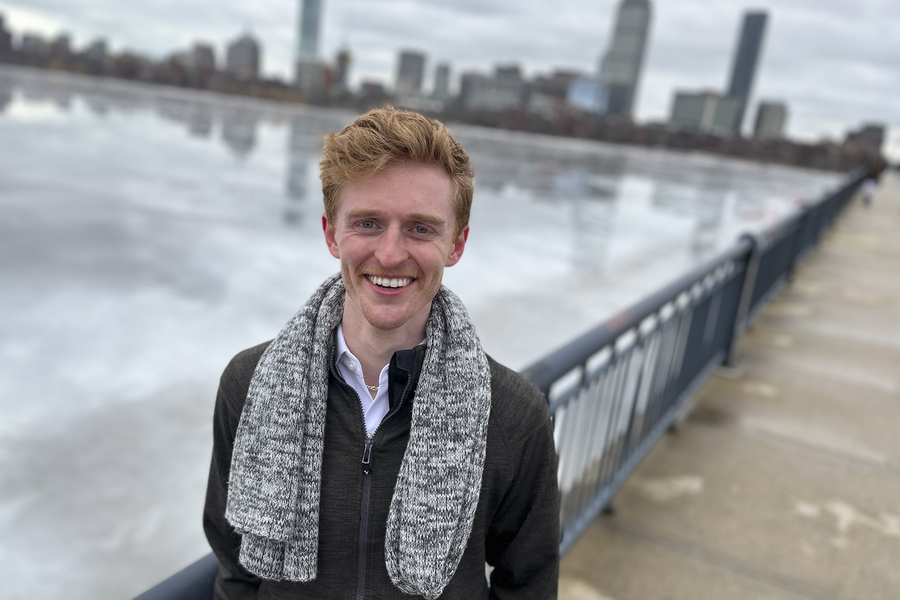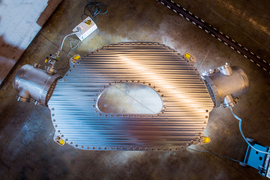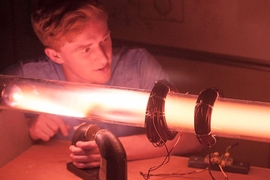Research scientist Alex Tinguely is readjusting to Cambridge and Boston.
As a postdoc with the Plasma Science and Fusion Center (PSFC), the MIT graduate spent the last two years in Oxford, England, a city he recalls can be traversed entirely “in the time it takes to walk from MIT to Harvard.” With its ancient stone walls, cathedrals, cobblestone streets, and winding paths, that small city was his home base for a big project: JET, a tokamak that is currently the largest operating magnetic fusion energy experiment in the world.
Located at the Culham Center for Fusion Energy (CCFE), part of the U.K. Atomic Energy Authority, this key research center of the European Fusion Program has recently announced historic success. Using a 50-50 deuterium-tritium fuel mixture for the first time since 1997, JET established a fusion power record of 10 megawatts output over five seconds. It produced 59 megajoules of fusion energy, more than doubling the 22 megajoule record it set in 1997. As a member of the JET Team, Tinguely has overseen the measurement and instrumentation systems (diagnostics) contributed by the MIT group.
A lucky chance
The postdoctoral opportunity arose just as Tinguely was graduating with a PhD in physics from MIT. Managed by Professor Miklos Porkolab as the principal investigator for over 20 years, this postdoctoral program has prepared multiple young researchers for careers in fusion facilities around the world. The collaborative research provided Tinguely the chance to work on a fusion device that would be adding tritium to the usual deuterium fuel.
Fusion, the process that fuels the sun and other stars, could provide a long-term source of carbon-free power on Earth, if it can be harnessed. For decades researchers have tried to create an artificial star in a doughnut-shaped bottle, or “tokamak,” using magnetic fields to keep the turbulent plasma fuel confined and away from the walls of its container long enough for fusion to occur.
In his graduate student days at MIT, Tinguely worked on the PSFC’s Alcator C-Mod tokamak, now decommissioned, which, like most magnetic fusion devices, used deuterium to create the plasmas for experiments. JET, since beginning operation in 1983, has done the same, later joining a small number of facilities that added tritium, a radioactive isotope of hydrogen. While this addition increases the amount of fusion, it also creates much more radiation and activation.
Tinguely considers himself fortunate to have been placed at JET.
“There aren't that many operating tokamaks in the U.S. right now," says Tinguely, "not to mention one that would be running deuterium-tritium (DT), which hasn't been run for over 20 years, and which would be making some really important measurements. I got a very lucky spot where I was an MIT postdoc, but I lived in Oxford, working on a very international project.”
Strumming magnetic field lines
The measurements that interest Tinguely are of low-frequency electromagnetic waves in tokamak plasmas. Tinguely uses an antenna diagnostic developed by MIT, EPFL Swiss Plasma Center, and CCFE to probe the so-called Alfvén eigenmodes when they are stable, before the energetic alpha particles produced by DT fusion plasmas can drive them toward instability.
What makes MIT’s “Alfvén Eigenmode Active Diagnostic” essential is that without it researchers cannot see, or measure, stable eigenmodes. Unstable modes show up clearly as magnetic fluctuations in the data, but stable waves are invisible without prompting from the antenna. These measurements help researchers understand the physics of Alfvén waves and their potential for degrading fusion performance, providing insights that will be increasingly important for future DT fusion devices.
Tinguely likens the diagnostic to fingers on guitar strings.
“The magnetic field lines in the tokamak are like guitar strings. If you have nothing to give energy to the strings — or give energy to the waves of the magnetic field lines — they just sit there, they don't do anything. The energetic plasma particles can essentially ‘play the guitar strings,’ strum the magnetic field lines of the plasma, and that's when you can see the waves in your plasma. But if the energetic particle drive of the waves is not strong enough you won’t see them, so you need to come along and ‘pluck the strings’ with our antenna. And that's how you learn some information about the waves.”
Much of Tinguely’s experience on JET took place during the Covid-19 pandemic, when off-site operation and analysis were the norm. However, because the MIT diagnostic needed to be physically turned on and off, someone from Tinguely’s team needed to be on site twice a day, a routine that became even less convenient when tritium was introduced.
“When you have deuterium and tritium, you produce a lot of neutrons. So, some of the buildings became off-limits during operation, which meant they had to be turned on really early in the morning, like 6:30 a.m., and then turned off very late at night, around 10:30 p.m.”
Looking to the future
Now a research scientist at the PSFC, Tinguely continues to work at JET remotely. He sometimes wishes he could again ride that train from Oxford to Culham — which he fondly remembers for its clean, comfortable efficiency — to see work colleagues and to visit local friends. The life he created for himself in England included practice and performance with the 125-year-old Oxford Bach Choir, as well as weekly dinner service at The Gatehouse, a facility that offers free support for the local homeless and low-income communities.
“Being back is exciting too,” he says. “It’s fun to see how things have changed, how people and projects have grown, what new opportunities have arrived.”
He refers specifically to a project that is beginning to take up more of his time: SPARC, the tokamak the PSFC supports in collaboration with Commonwealth Fusion Systems. Designed to use deuterium-tritium to make net fusion gains, SPARC will be able to use the latest research on JET to advantage. Tinguely is already exploring how his expertise with Alfvén eigenmodes can support the experiment.
“I actually had an opportunity to do my PhD — or DPhil as they would call it — at Oxford University, but I went to MIT for grad school instead,” Tinguely reveals. “So, this is almost like closure, in a sense. I got to have my Oxford experience in the end, just in a different way, and have the MIT experience too.”
He adds, “And I see myself being here at MIT for some time.”









